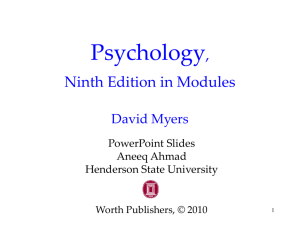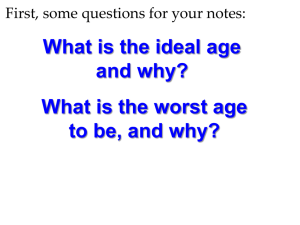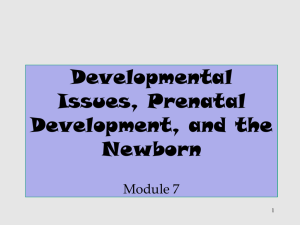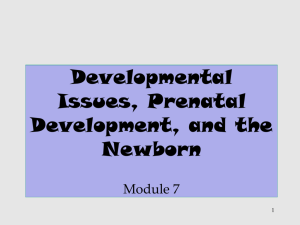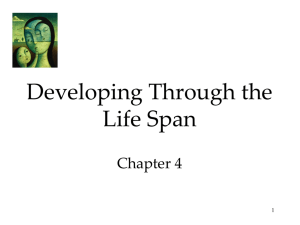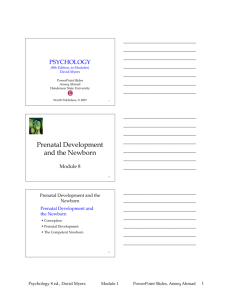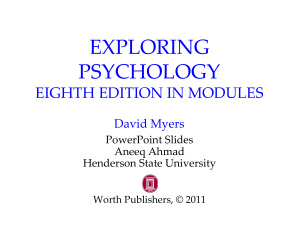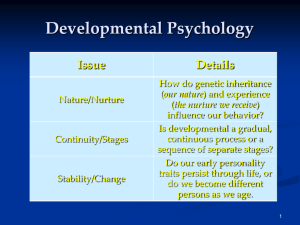File
advertisement
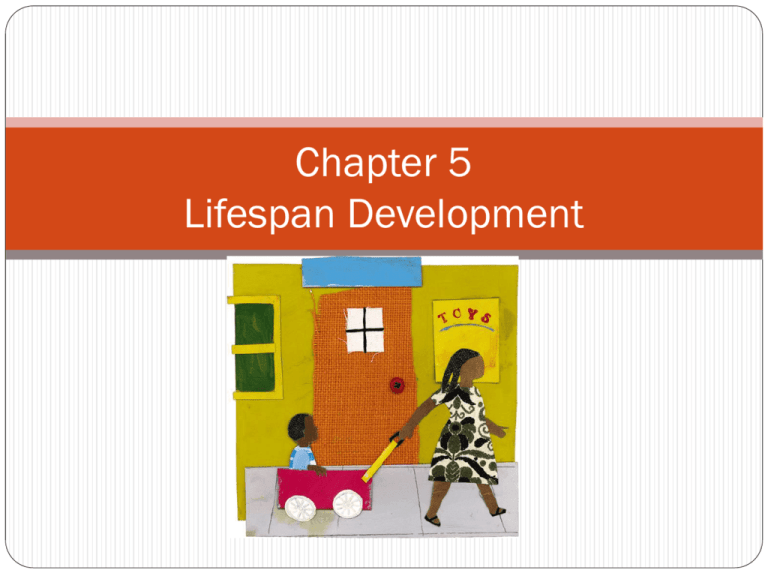
Chapter 5 Lifespan Development Developing Through the Life Span Prenatal Development and the Newborn Conception Prenatal Development The Competent Newborn Infancy and Childhood Physical Development Cognitive Development Social Development Adolescence Physical Development Cognitive Development Social Development Emerging Adulthood Adulthood Physical Development Cognitive Development Social Development Reflections on Two Major Developmental Issues Continuity and Stages Stability and Change Developmental Psychology Issue Nature/Nurture Continuity/Stages Stability/Change Details How do genetic inheritance (our nature) and experience (the nurture we receive) influence our behavior? Is development a gradual, continuous process or a sequence of separate stages? Do our early personality traits persist through life, or do we become different persons as we age. Prenatal Development and the Newborn How, over time, did we come to be who we are? From zygote to birth, development progresses in an orderly, though fragile, sequence. Conception A single sperm cell (male) penetrates the outer coating of the egg (female) and fuses to form one fertilized cell. Lennart Nilsson/ Albert Bonniers Publishing Company Lennart Nilsson/ Albert Bonniers Publishing Company Prenatal Development A zygote is a fertilized egg with 100 cells that become increasingly diverse. At about 14 days the zygote turns into an embryo (a and b). Biophoto Associates/ Photo Researchers, Inc. Lennart Nilsson/ Albert Bonniers Publishing Company Prenatal Development At 9 weeks, an embryo turns into a fetus (c and d). Teratogens are chemicals or viruses that can enter the placenta and harm the developing fetus. Lennart Nilsson/ Albert Bonniers Publishing Company Lennart Nilsson/ Albert Bonniers Publishing Company The Competent Newborn Infants are born with reflexes that aid in survival, including rooting reflex which helps them locate food. The Competent Newborn Offspring cries are important signals for parents to provide nourishment. In animals and humans such cries are quickly attended to and relieved. Lightscapes, Inc. Corbis Carl and Ann Purcell/ Corbis Infancy and Childhood Infancy and childhood span from birth to the teenage years. During these years, the individual grows physically, cognitively, and socially. Stage Span Infancy Newborn to toddler Childhood Toddler to teenager Physical Development Infants’ psychological development depends on their biological development. To understand the emergence of motor skills and memory, we must understand the developing brain. 13 Developing Brain At birth, most brain cells are present. After birth, the neural networks multiply resulting in increased physical and mental abilities. 14 Vision and Depth Perception Eyes functioning at birth but a little fuzzy 6-8 months see as well as a college student Perceive depth in a 3-D world develops between 6-12 months Visual Cliff Clip Temperament Emotional reactions and emotional self regualtion Genetic Predispositions (biological) Prenatal Influences Combination biological and Environmental Reactions reinforce behavior Maturation The development of the brain unfolds based on genetic instructions, causing various bodily and mental functions to occur in sequence— standing before walking, babbling before talking—this is called maturation. Maturation sets the basic course of development, while experience adjusts it. 18 Motor Development First, infants begin to roll over. Next, they sit unsupported, crawl, and finally walk. Experience has little effect on this sequence. Profimedia.CZ s.r.o./ Alamy Phototake Inc./ Alamy Images Jim Craigmyle/ Corbis Renee Altier for Worth Publishers 19 Maturation and Infant Memory The earliest age of conscious memory is around 3½ years (Bauer, 2002). A 5-year-old has a sense of self and an increased long-term memory, thus organization of memory is different from 3-4 years. Courtesy of Carolyn Rovee-Collier Amy Pedersen 20 Cognitive Development Piaget believed that the driving force behind intellectual development is our biological development amidst experiences with the environment. Our cognitive development is shaped by the errors we make. Both photos: Courtesy of Judy DeLoache 21 Schemas Schemas are mental molds into which we pour our experiences. 22 Assimilation and Accommodation Bill Anderson/ Photo Researchers, Inc. The process of assimilation involves incorporating new experiences into our current understanding (schema). The process of adjusting a schema and modifying it is called accommodation. Jean Piaget with a subject 23 Piaget’s Theory and Current Thinking 24 Foldable • You will need 2 pieces of construction paper (or reg. paper if you prefer) • Fold “hotdog” style • Cut 4 flaps on 1 sheet • Cut 3 flaps on the other sheet 25 Sensorimotor Stage In the sensorimotor stage, babies take in the world by looking, hearing, touching, mouthing, and grasping. Children younger than 6 months of age do not grasp object permanence, i.e., objects that are out of sight are also out of mind. Doug Goodman 26 Sensorimotor Stage: Criticisms Piaget believed children in the sensorimotor stage could not think —they do not have any abstract concepts or ideas. However, recent research shows that children in the sensorimotor stage can think and count. 1. Children understand the basic laws of physics. They are amazed at how a ball can stop in midair or disappear. 27 Sensorimotor Stage: Criticisms 2. Children can also count. Wynn (1992, 2000) showed that children stared longer at the wrong number of objects than the right ones. 28 Preoperational Stage Piaget suggested that from 2 years old to about 6-7 years old, children are in the preoperational stage—too young to perform mental operations. Ontario Science Center 29 Egocentrism Piaget concluded that preschool children are egocentric. They cannot perceive things from another’s point of view. When asked to show her picture to mommy, 2year-old Gabriella holds the picture facing her own eyes, believing that her mother can see it through her eyes. 30
